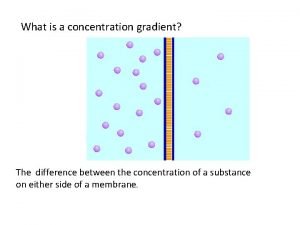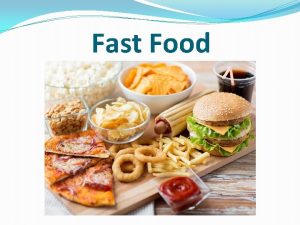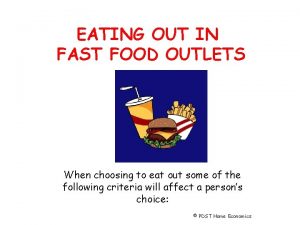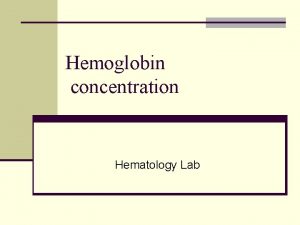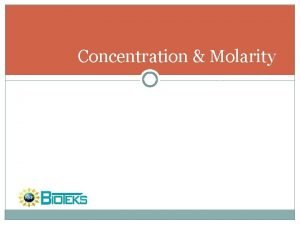Concentration of Fast Food Outlets Associated with Poor









- Slides: 9

Concentration of Fast. Food Outlets Associated with Poor Nutrition and Obesity Megan Beyer KNH 304

Background As 66% of Americans are currently overweight or obese there is a need to understand the contributing factors. There is a link between frequent fast-food consumption reflecting a high-fat diet, reduced fruit and vegetable consumption, low fiber and lower physical activity. The geographical concentration of fast-food outlets may be associated with an increase in overweight and obesity.

Introduction There was a 25 -minute phone survey created by Michigan Public Health Institute in Genesee County, Michigan that 1345 people participated in ranging from age 37 - 71 years old. Participants were 70% female and 30% male. The study utilized a Geographical information system (GIS) to analyze geographical location of fast-food outlets from the participants home location.

Methods Random participants from the Genesee County census tracker took a survey called “The Speak to Your Health!”. There were self-report measurement of height and weight to calculate BMI along with the number of servings of fruit and vegetable consumed each day. The survey also indicated if the participant performed at least 30 minutes of exercise 5 days per week. Demographic items for each participant were also completed including race, sex, education, residence and BMI.

Results The local concentration of fast-food outlet significantly predicted lower fruit and vegetable consumption and higher BMI. There was a range of 1 -15 fast-food outlets within 2 miles of the participants home. For every standard deviation increased in fast-food concentration, BMI increased by 9% of a standard deviation.

Discussion This study utilized GIS to demonstrate the concentration of fast-food outlets, which is related to higher BMI, and decreased consumption of fruits and vegetables. The finding were only based upon households with landline phones. Also since there was high refusal rate to participate in the survey, this resulted in an overrepresentation of older, more highly educated, and female individuals.

Conclusion There were limitations of self reported measurements such as weight that would affect the accuracy ad precision of the survey. People may be at greater risk for adverse health consequences or poor nutrition because of patterns in local food availability, which may constrain nutrition promotion efforts.

Application This survey that was completed was very interesting because as there have been previous studies that have looked at the relationship of obesity and fast-food locations, the GIS system used was a much more precise way to measure it. With obesity on the rise we need to promote positive eating habits and choosing healthier options at fast-food locations. Since people are going to eat at these locations no matter what, it is important to do further research on what people are ordering at these locations.

Sources Article Name- Local Concentration of the Fast-Food Outlets is Associated with Poor Nutrition and Obesity Citation Kruger, D. , & Greenberg, E. (2014). Local Concentration of Fast-Food Outlets Is Associated With Poor Nutrition and Obesity. American Journal of Health Promotion, 28(5), 340 -343. doi: 10. 4278
 Concentration gradient vs concentration difference
Concentration gradient vs concentration difference Movement of high concentration to low concentration
Movement of high concentration to low concentration Food product design by eric schlosser
Food product design by eric schlosser Fast food can be defined as any food that contributes
Fast food can be defined as any food that contributes Non acid fast bacteria
Non acid fast bacteria Example of acid-fast bacteria
Example of acid-fast bacteria What are sentinel outlets
What are sentinel outlets Ckt motor perlis
Ckt motor perlis Tri-tech medical inc.
Tri-tech medical inc. Unit 2 food food food
Unit 2 food food food
